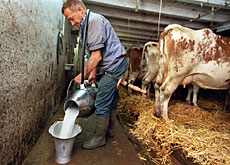Bluetongue reaches Switzerland

The Swiss veterinary authorities have registered the first case of bluetongue disease in the country, after cows were infected near Basel.
The illness, which is not considered dangerous for humans but can devastate animal herds, has spread from Germany and France and is affecting much of northwestern Europe.
The Federal Veterinary Office announced on Sunday that six of 19 animals in a herd had tested positive for bluetongue. One cow presented severe symptoms and was put down.
Patrick Gerber, whose farm sits north of the Rhine, told Swiss television that it was obvious that something was wrong with some of his animals on Thursday.
The viral disease is transmitted by insect bites; in this case a particular species of midge. It is not passed on between animals.
Although bluetongue is not dangerous for humans, the meat from infected animals is not used and their carcasses are eliminated according to Basel City’s cantonal vet, Markus Spichtig.
Owners are reimbursed 90 per cent of a diseased animal’s value by the Swiss authorities.
Protection zone
On Monday a protection zone with a 20-kilometre radius was set up around the farm. Cows, sheep and goats will not be allowed to leave the area except to be slaughtered and only with permission from the cantonal vet.
Other measures inside the zone include moving animals inside before dusk. The aim of the authorities is to slow the spread of the disease by preventing diseased ruminants from travelling to other parts of Switzerland and to avoid contact between animals and midges.
But there is a high chance that the disease will continue to progress and that there will be more outbreaks, the veterinary office has warned. Bluetongue only appears two to three weeks after infection, meaning more cases might be on the way.
“It’s a very difficult situation,” said Thomas Wyss, head of the veterinary office. “The disease has spreading across parts of Europe very quickly and we knew it was coming here.”
Difficult to control
It is difficult to stop because of the way it is transmitted, since there are few methods available for dealing with midges, Wyss told Swiss television.
The authorities are hoping for a spell of cold weather that would cut the insect population.
According to the Paris-based World Organisation for Animal Health, there is no treatment available for bluetongue.
Vaccination is also problematic because it must correspond closely to the infection in a given area. Wyss said that he is hoping that a vaccine would be available next year.
swissinfo with agencies
Bluetongue is a non-contagious, insect-transmitted, viral disease of sheep and wild ruminants. It is not known to affect humans.
The disease is characterised by inflammation of the mucous membranes, congestion, swelling and haemorrhages.
Sheep are generally the worst affected, while cattle and goats do not usually show any clinical signs of disease and can carry the virus for a certain period of time.
Transmission takes place via the bite of certain species of Culicoides midges. It is not transmitted by direct or indirect contact between animals in the absence of the insects.
The bluetongue virus has been shown to be present in regions where the Culicoides is present – Africa, the Americas, Australia, the Middle East and some countries of southern Asia and Oceania.

In compliance with the JTI standards
More: SWI swissinfo.ch certified by the Journalism Trust Initiative











You can find an overview of ongoing debates with our journalists here . Please join us!
If you want to start a conversation about a topic raised in this article or want to report factual errors, email us at english@swissinfo.ch.